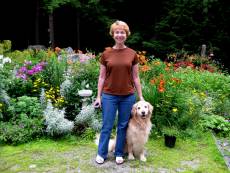
I'm taking this really cool class on culinary gardening at PBCC taught by Lloyd Singleton, the manager of the gardens at the Breakers Hotel in Palm Beach. He took us on a tour of the culinary gardens where they grow many of the vegetables and herbs used in L’Escalier, their French restaurant.
The fruits are green or yellow at first, turning brown as they mature. The coconuts were picked for us, and the hard outer layer carved to a point so we could open them easily.



Inside the shell is a thin, white, fleshy layer, known as the "meat" or copra. The meat is soft and jelly-like when immature, but it becomes firm at maturity. You can spoon the meat out and eat it.
Palm Beach got its name from the coconut palm tree which grows along tropical, sandy shorelines. It can also be grown inland. One tree can produce between 50 to 200 coconuts a year. At the Breakers, these are all removed before Hurricane season starts in June.
After the tour we got a real treat - a drink of coconut milk from a fresh coconut. The interior of a coconut is hollow, but partially filled with a watery liquid called "coconut milk". The milk is found in unripe fruits, and is gradually absorbed as the fruit ripens.
The fruits are green or yellow at first, turning brown as they mature. The coconuts were picked for us, and the hard outer layer carved to a point so we could open them easily.

You make a small opening in the top using a machete.

Then you drink the coconut juice with a straw.

Inside the shell is a thin, white, fleshy layer, known as the "meat" or copra. The meat is soft and jelly-like when immature, but it becomes firm at maturity. You can spoon the meat out and eat it.
Palm Beach got its name from the coconut palm tree which grows along tropical, sandy shorelines. It can also be grown inland. One tree can produce between 50 to 200 coconuts a year. At the Breakers, these are all removed before Hurricane season starts in June.





 The second week we learned how to select plants for the garden, and how to propogate plants from cuttings. We made 4-6 inch cuttings, removed all but a few leaves, dipped them in rooting hormone, then put them into oasis that looks like this. They also went under the mist.
The second week we learned how to select plants for the garden, and how to propogate plants from cuttings. We made 4-6 inch cuttings, removed all but a few leaves, dipped them in rooting hormone, then put them into oasis that looks like this. They also went under the mist.  The third week we learned about soils, fertilizers, and one of my favorite topics, composting. We tested our soil to determine the pH, and nitrogen, phosphorous, and potassium requirements.
The third week we learned about soils, fertilizers, and one of my favorite topics, composting. We tested our soil to determine the pH, and nitrogen, phosphorous, and potassium requirements.




 Agaves are easily propagated by taking the offsets from the base of the stem. The students in my 'South Florida Gardening Course' each took home a baby of this plant.
Agaves are easily propagated by taking the offsets from the base of the stem. The students in my 'South Florida Gardening Course' each took home a baby of this plant.



 Jakfruit - the world's largest fruit which can weigh over 70 lbs.
Jakfruit - the world's largest fruit which can weigh over 70 lbs.




















